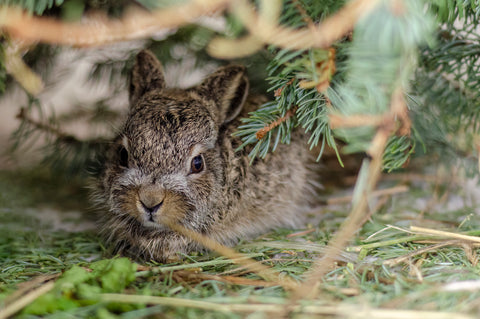
Notice: A $5.00 fee will automatically be added at checkout for physical mail-outs to cover printing and shipping. If recipient information is not provided, the certificate will be sent to the email or mailing address listed in the customer’s billing information.
(Lepus townsendii).
Date of admission: May, 2025.
Reason for admission: Orphaned.
Patient History:
The White-tailed Prairie Hare, also commonly referred to as 'white-tailed jackrabbit,' is a species of hare found in west-central Canada and the United States. They range from Saskatchewan to Alberta and as far east as southwest Ontario. Despite what nicknames might suggest, the 'Hare' is not a 'Rabbit,' though rabbits and hares are a member of the family Leporidae of the order Lagomorpha. An adult hare’s diet includes a wide variety of grasses, the buds of shrubs, and the bark of small trees.
The coloring of a white-tailed prairie hare is dependent on season and habitat. During warmer months, and more temperate climates, the hare is easily identified by its large, round, grey/brown ears with black tips and a white interior. The back and limbs are dark brown or greyish-brown and the underparts are pale grey or white. The tail is always white with a dark buff stripe above. In northern populations, autumn brings a molt in this species, and we see a change from grey/brown body coloration to a pure white coloration for better winter camouflage. In early to late spring another molt reverses this process. Females may appear slightly larger in size.
White-tailed prairie hares are solitary except during the breeding season when several males will actively compete to breed with the females. The breeding season is variable depending on several environmental factors but can be as early as February and as late as March, with females giving birth to multiple litters in the summer. A female hare will give birth to an average of 4-5 young in a fur-lined nest carefully hidden under dense vegetation. Young hares, or "leverets," weigh a mere 100 grams (3.5 ounces) at birth and are fully furred with their eyes open. Being a prey species, they do not remain in their nest for long, and grow rapidly to adapt to their environment. Their subsequent independence is almost immediate, with young exploring at one to two weeks of age, and typically being weaned at three to four weeks. When they are still quite young, the female will often scatter her young in the morning across an open space that she believes to be safe. Due to their natural camouflage, they can remain still and hidden, until mum returns at dusk. This is a form of preservation, as a large group of hares clustered together is much easier to spot by a predator. It is common for homeowners to discover young hares hiding in their backyards. Unless there is an obvious injury, we always recommend leaving them be as Mum is likely close.
We receive leverets for various reasons, the most common being; a suspected orphan, and/or domestic animal attacks. With your support, they receive care until they're ready to thrive on their own. In 2024, we cared for 97 white-tailed prairie hares at our facility.
